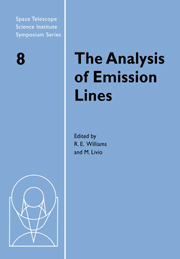Book contents
- Frontmatter
- Contents
- Participants
- Preface
- Emission Lines: Past and Future
- Atomic Data for the Analysis of Emission Lines
- Radiative Transfer
- Emission Lines from Winds
- Photoionizing Shocks
- The Lexington Benchmarks for Numerical Simulations of Nebulae
- Emission Line Diagnostics
- Ultraviolet Spectroscopy
- Infrared Emission Lines as Probes of Gaseous Nebulae
- Molecular Emission Line Diagnostics in Astrophysical Environments
- Abundance Determinations
- Astrophysical Gamma Ray Emission Lines
- Summary Remarks
Emission Line Diagnostics
Published online by Cambridge University Press: 23 November 2009
- Frontmatter
- Contents
- Participants
- Preface
- Emission Lines: Past and Future
- Atomic Data for the Analysis of Emission Lines
- Radiative Transfer
- Emission Lines from Winds
- Photoionizing Shocks
- The Lexington Benchmarks for Numerical Simulations of Nebulae
- Emission Line Diagnostics
- Ultraviolet Spectroscopy
- Infrared Emission Lines as Probes of Gaseous Nebulae
- Molecular Emission Line Diagnostics in Astrophysical Environments
- Abundance Determinations
- Astrophysical Gamma Ray Emission Lines
- Summary Remarks
Summary
This review focus on three major aspects of emission line diagnostics: Line intensities that are used to deduce the physical conditions in the gas, line profiles that are needed to study the gas dynamics, and line variability, that is used to obtain the gas distribution. Applications and examples are given for active galaxies and quasars. The status of research and the outstanding problems in each of these areas are discussed and new observational findings are shown. The more important developments of recent years are due to systematic, combined space and groundbased observations of individual objects (reverberation mapping) as well as studies of large samples of AGNs (e.g. the HST radio-loud sample).
Introduction and overview of active galactic nuclei
Observations of emission lines in photoionized nebulae provide important diagnostics of the line emitting gas in three different ways: Line intensities are used to derive the physical conditions in the gas. Density, temperature, optical depth etc. are all related to emission line ratios and absolute fluxes. Line profiles are used to investigate the gas dynamics and the velocity field. Finally, line variability, when correlated with flux variations of the photoionizing continuum, are used to measure the gas distribution and the size of the emission line region.
Active Galactic Nuclei (AGN) are situated in the center of otherwise normal galaxies and show strong emission lines superimposed on strong nonstellar continua.
- Type
- Chapter
- Information
- The Analysis of Emission Lines , pp. 97 - 106Publisher: Cambridge University PressPrint publication year: 1995

